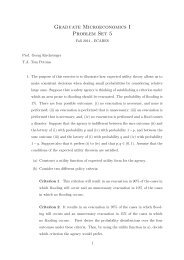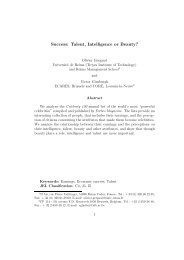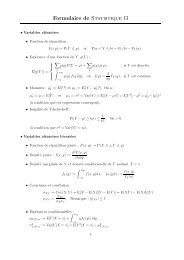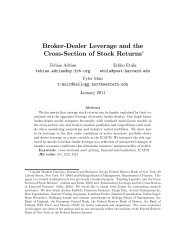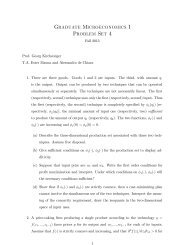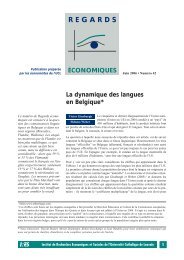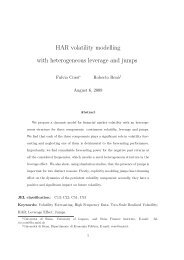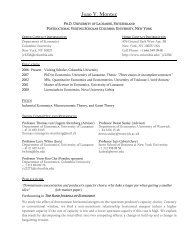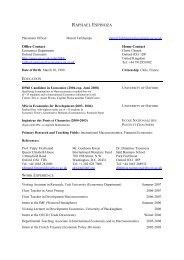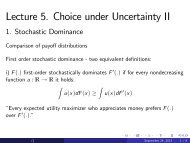Switching Costs in Two-sided Markets - Ecares
Switching Costs in Two-sided Markets - Ecares
Switching Costs in Two-sided Markets - Ecares
- No tags were found...
You also want an ePaper? Increase the reach of your titles
YUMPU automatically turns print PDFs into web optimized ePapers that Google loves.
This equation shows that the number of agents from side i belong<strong>in</strong>g to platform 0 <strong>in</strong> thesecond period is the sum of three terms. The first element represents with probability µ ithe old customers are loyal. The second and third terms represent with probability 1−µ ithe old customers are switchers (whose preferences are unrelated <strong>in</strong> the two periods):they can either be switchers who did not switch away from platform 0 or switchers whoactually switched from platform 1 to platform 0.Then solv<strong>in</strong>g for n A 0,2 and nB 0,2 simultaneously, we obta<strong>in</strong> the second-period marketshares of groups A and B as follows:wheren i 0,2 = γ + β i + (1 − µ i )(p i 1,2 − pi 0,2 ) + e i(1 − µ i )(1 − µ j )(p j 1,2 − pj 0,2 ),2γγ =1 − (1 − µ A )(1 − µ B )e A e B ,β i =(2n i 0,1 − 1)(µ i + (1 − µ i )s i ) + (2n j 0,1 − 1)(1 − µ i)e i (µ j + (1 − µ j )s j ).S<strong>in</strong>ce I have assumed at the beg<strong>in</strong>n<strong>in</strong>g that e i < 1, so γ > 0.The respective second-period profit of platforms 0 and 1 can be written as:π 0,2 = p A 0,2n A 0,2 + p B 0,2n B 0,2,π 1,2 = p A 1,2(1 − n A 0,2) + p B 1,2(1 − n B 0,2).Substitute n A 0,2 (pA 0,2 , pA 1,2 , pB 0,2 , pB 1,2 ) and nB 0,2 (pA 0,2 , pA 1,2 , pB 0,2 , pB 1,2 ) <strong>in</strong>to these two profit functions.Then, by differentiat<strong>in</strong>g π 0,2 with respect to p A 0,2 and pB 0,2 , and differentiat<strong>in</strong>g π 1,2with respect to p A 1,2 and pB 1,2 , we obta<strong>in</strong> 4 equations and 4 unknowns.∂π 0,2∂p i 0,2∂π 1,2∂p i 1,2= n i 0,2 − pi 0,22γ (1 − µ i) − pj 0,22γ e j(1 − µ i )(1 − µ j ),= 1 − n i 0,2 − pi 1,22γ (1 − µ i) − pj 1,22γ e j(1 − µ i )(1 − µ j ).Solv<strong>in</strong>g the system of first-order conditions, one f<strong>in</strong>ds the follow<strong>in</strong>g four second-periodequilibrium prices.wherep i 0,2 = 1 − e j(1 − µ i )1 − µ i+ η iλ i + ɛ i λ j(1 − µ i )∆ , (1)p i 1,2 = 1 − e j(1 − µ i )1 − µ i− η iλ i + ɛ i λ j(1 − µ i )∆ . (2)∆ = 9 − (1 − µ A )(1 − µ B )(e A + 2e B )(e B + 2e A ) > 0,λ i = (2n i 0,1 − 1)(µ i + (1 − µ i )s i ),η i = 3 − e j (e j + 2e i )(1 − µ i )(1 − µ j ) > 0,ɛ i = (1 − µ i )(e i − e j ).6



